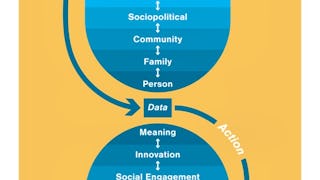This second of five courses focuses on how social determinants of health affects vulnerable populations. Focusing on four groups of vulnerable populations, students will examine how social determinants of health contribute to the poor health outcomes experienced by these populations. The topics of this course include:


Social Determinants of Health: Vulnerable Populations
包含在  中
中
您将获得的技能
要了解的详细信息
了解顶级公司的员工如何掌握热门技能

积累特定领域的专业知识
- 向行业专家学习新概念
- 获得对主题或工具的基础理解
- 通过实践项目培养工作相关技能
- 获得可共享的职业证书

该课程共有5个模块
In this module, we will discuss how poverty relates to health as we examine the interrelationships between poverty and other social determinants of health. In lesson one, we will define poverty, as we explore how poverty both causes and is caused by poor health. We will also look at some policy perspectives aimed at eradicating poverty. In lesson two, we will continue our discussion from lesson one, as we evaluate different approaches, perspectives and solutions to ending poverty. We will also consider how success is measured when evaluating the effectiveness of these proposed interventions.
涵盖的内容
3个视频7篇阅读材料2个作业1个讨论话题5个插件
In this module, we will consider the gender-specific impact of social determinants of health on women. In lesson one, we will review what defines a health inequity for women and examine how gender acts as an axis of health disparity. Lesson two focuses on reproductive health and the need for contraception. We will look at how the SDOH shape resources and accessibility for women at global and national levels, and how reproductive rights are tied to human rights for girls and women. Lesson three continues to build on the content from previous lessons, with a more in-depth look at maternal health. We will investigate how the SDOH impacts aspects of maternal health with a focus on pregnancy related mortality and its prevalence on global and national levels. We will also examine how structural racism drives health disparities and specifically, maternal outcomes. In lesson four, we will summarize the factors that shape gender-based health disparities and the impact on women, while investigating policy-based strategies and resources to improve health outcomes for women while addressing SDOHs.
涵盖的内容
4个视频13篇阅读材料2个作业1个讨论话题
In this module, we focus on the social determinants of health in LGBTQI+ populations. In lesson one, we will define important terminology related to LGBTQI+ health needs as we look at LGBTQI+ vulnerabilities to the social determinants of health. In lesson two, we will examine how heteronormativity and cisnormativity can act as negative social determinants of LGBTQI+ health and wellbeing as we consider how media and language can perpetuate these inequalities. In lesson three, we consider how microaggressions, discrimination, and implicit bias can contribute to a healthcare system bias that negatively impacts the accessibility and quality of care received by LGBTQI+ patients. In lesson four, we will review key dates in LGBTQI+ history in the United States, as we investigate social and structural level changes that can improve LGBTQI+ health outcomes.
涵盖的内容
4个视频7篇阅读材料2个作业1个讨论话题2个插件
In this module, we will examine the social determinants of health for families with young children and discuss policy-based strategies for improving health outcomes. In lesson one, we’ll explore the Rainbow Model as a way to understand how social determinants affect the health of young children. We will also review the different pathways through which socioeconomic circumstances influence health and contribute to child health inequalities. Applying what we learned in the previous lesson, in lesson two, we will look at a case study in order to investigate how social determinants influence a family’s ability to promote child health. Finally in lesson three, we will analyze some strategies for improving health outcomes for families with young children through policies that address social determinants of health.
涵盖的内容
3个视频2篇阅读材料2个作业1个讨论话题
This module will focus on analyzing, displaying and interpreting social determinants of health data, with a particular focus on comparing social determinants by group. Lesson one will provide an overview of t-test analysis and box plot visualization. In lesson two, we will learn how to conduct t-test analyses and create boxplots in R. Using the NHANES dataset, we will compare general health and Hgb a1c by gender. Using the Omaha System dataset, we will compare total signs & symptoms, social determinant of health signs & symptoms, and income signs & symptoms by gender. Finally, we will discuss how to interpret the results of our analysis as we visualize our findings using boxplots.
涵盖的内容
2个视频3篇阅读材料1次同伴评审1个讨论话题1个非评分实验室3个插件
获得职业证书
将此证书添加到您的 LinkedIn 个人资料、简历或履历中。在社交媒体和绩效考核中分享。
位教师


从 Health Informatics 浏览更多内容
 状态:免费试用
状态:免费试用University of Minnesota
 状态:免费试用
状态:免费试用University of Minnesota
 状态:免费试用
状态:免费试用University of Michigan
 状态:免费试用
状态:免费试用University of Minnesota
人们为什么选择 Coursera 来帮助自己实现职业发展




常见问题
To access the course materials, assignments and to earn a Certificate, you will need to purchase the Certificate experience when you enroll in a course. You can try a Free Trial instead, or apply for Financial Aid. The course may offer 'Full Course, No Certificate' instead. This option lets you see all course materials, submit required assessments, and get a final grade. This also means that you will not be able to purchase a Certificate experience.
When you enroll in the course, you get access to all of the courses in the Specialization, and you earn a certificate when you complete the work. Your electronic Certificate will be added to your Accomplishments page - from there, you can print your Certificate or add it to your LinkedIn profile.
Yes. In select learning programs, you can apply for financial aid or a scholarship if you can’t afford the enrollment fee. If fin aid or scholarship is available for your learning program selection, you’ll find a link to apply on the description page.
更多问题
提供助学金,
¹ 本课程的部分作业采用 AI 评分。对于这些作业,将根据 Coursera 隐私声明使用您的数据。




